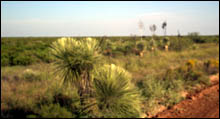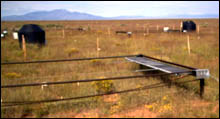An Ecological and Information Management Perspective of the US-LTER
|
- Avinash Chuntharpursat
Well, I'm back in the office recovering from a very well rounded and informative trip to the LTER sites of the USA, the All Scientist Meeting, US-LTER Information Management Meeting and the International LTER IM Committee Meeting. (Please pardon the many abbreviations and acronyms, there's a list at the end of the article).
Now where do I begin? Let me start by getting over the ecological "wow" aspects of the US-LTER sites that we visited: Jornada, Sevilleta, Central Arizona - Phoenix and Florida Coastal Everglades. I'll leave the more academic issues of the various ecosystems that we visited to the ecologists at SAEON and concentrate on some of the more personally appealing aspects. This trip has physically exposed me to concepts, animals, fish and plants that I have grown up with both in my professional career and as a youngster with a passion for ecology.
As an avid aquarist, one of the families of fish that I have a profound interest in Poeciliidae. What is so fascinating about these fishes is that they are live-bearers, which means that they give birth to live young. The more commonly available members of this family are the guppies, mollies, platys and swordtails. As a hobby I kept and bred just about every species of Poeciliidae available in South Africa. However, I was intrigued by one which I encountered in books but which was largely unavailable in South Africa - Belonesox belizanus (Fig. 1). Belonesox is the largest of the live-bearers - reaching a length of 15-20cm - and is highly predatory on other fish species.
A predatory livebearer! I simply had to see one and this trip offered me the opportunity to do just that. It happened in the Florida Everglades. A shoal of three was swimming near the surface. Unfortunately, this was not an experience of seeing Belonesox in the wild. The Florida Everglades is not the natural habitat of the Belonesox. Upon further research, I discovered that Belonesox is an important medical research fish and that a population was released into canals in 1957 from a medical research programme that had its funding terminated. It was from this canal that Belonesox then spread into the Everglades.
On the receiving end of the Belonesox introduction was another member of the family Poeciliidae - the humble mosquito fish (Gambusia spp), so named for its voracious appetite for mosquito larvae. Mosquito fish seem to be ubiquitous in the Everglades (Fig. 2) in the vegetated swamps, open water and puddles drying on the road. According to some reports, Belonesox has all but eliminated the mosquito fish from certain canals, thus disrupting mosquito control. Another native live-bearer is the sailfin molly, but swarms of mosquitoes prevented me from catching a good look at them. (The South African generic brand of insect repellent that I used didn't work at all!)
Enough about fish. The Jornada and Sevilleta sites yielded some interesting flora. Of particular note were the different species of yucca. As a former plant breeder and horticulturist, I was fascinated to see this common garden and potted ornamental plant growing in its natural habitat. At the Jornada site (Fig. 3), large yucca plants often dominated the landscape.
Another interesting aspect of the vegetation of Jornada is that it is the natural habitat of mesquite (Fig. 4) and a solanaceous plant commonly refered to in South Africa as 'gifappel'. Both these plants grow in South Africa with the gifappel being a noxious weed and mesquite being somewhat invasive but a useful fodder plant.
Seeing the roadrunner (associated with a cartoon character) in the wild was another fascinating experience. Unfortunately coyote were elusive in Jornada.
The vegetation and experimental trials in Sevilleta also held particular interest for me. Once again I had a chance to see some of our common ornamentals in their native habitats. There were yucca, pinions, junipers and cacti (including some Opuntia species). Figure 5 illustrates the species of yucca found at the Sevilleta site.
Figure 6 shows a pinion and juniper woodland. At the time of the visit, experimental plots were being set up. Juniper berries are an ingredient in the production of gin. In the past, the berries were also used as a substitute for pepper. Interestingly, a two-metre-high juniper tree can easily be centuries old. Note the two species of Opuntia in the bottom left of the picture.
There was a diverse array of ecological experiments ongoing at the Sevilleta site. Figure 7 illustrates an experiment whereby ambient heat is trapped under a cover to raise night-time temperatures. This is to measure the effect of an increase in temperature on the vegetation. Figures 8 and 9 are illustrations of experiments to measure the effects of drought and increases in rainfall respectively.
A lot has been happening on the Information Management front, especially with regard to the implementation of the Ecological Metadata Language (EML). Since I last attended a US-LTER IM meeting in Canada (2005), there has been a significant improvement in the implementation of EML at the individual sites.
An ILTER - IM workshop was held during the ASM. In a previous article, I mentioned the formation and first meeting of the ILTER-IM committee at Gobabeb Research Station in Namibia, where I was elected Vice-Chairman. Due to the availability of numerous ILTER information/ data specialists, the ASM afforded a splendid opportunity to hold our second meeting. At this meeting, the three globally relevant IM systems were demonstrated: EML from US and Taiwan, Ontologies from Europe and CoGIS from South Africa. In implementing an international IMS, the committee has decided on taking the strengths of each of these systems and integrating them into a single system. Currently, plans are underway to translate the ontologies from Austrian into English.
During the course of the ASM I was given several opportunities to demonstrate the CoGIS at various forums and individually to numerous information/ data specialists. Valuable feedback was received from the ILTER committee coordinated by the Mexican LTER data manager, who is looking at spatially enabling the numerous ILTER sites on the CoGIS. (SAEON is currently working out a hosting agreement for the CoGIS, so hold on a bit guys). All these demonstrations were done live off the internet from a temporary website in South Africa. This was a really stressful situation for yours truly but fortunately, all worked out thanks to the CoGIS developers "i-kno" (formerly known as Agileworks . . . I know it's a weird name).
All in all this trip provided this information guy with a well balanced view of the ecological research and data management developments in the US. As part of ILTER, SAEON has an important role to play in ensuring international collaboration in research and the resultant information management. I certainly look forward to working with all my international colleagues.
List of Acronyms
- ASM = All Scientist Meeting
- CoGIS = Collaborative Geographical Information System
- EML = Ecological Metadata Language
- LTER = Long Term Ecological Research
- ILTER = International Long Term Ecological Research
- IM = Information Management
- IMS = Information Management System



















